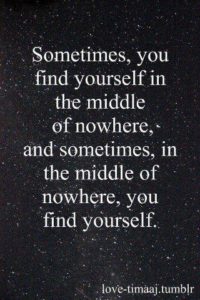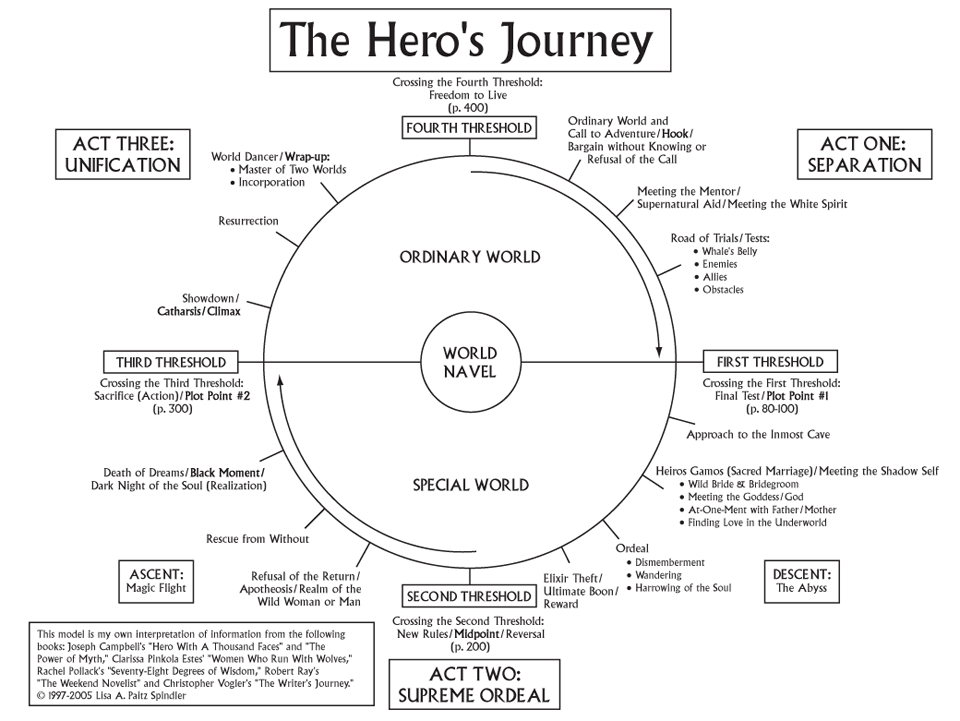Phase 2 of my departure from a stable job with a paycheck and benefits. A leap of faith – a step towards my undeniable destiny. A willingness to take a chance on myself, my potential and my unexpressed talents. This is terrifying. I mean really, really terrifying.
It’s not that I now have to pick food out of the dumpster behind the nearest McDonalds. It’s not that I have to put a kidney on ebay to make rent this month. It’s the massive santa-like sack of beliefs that I have toted around for all my adult life (I am sure I toted around an oversized kid version too) that now I am forced to unpack to make the journey lighter. This task is as much fun as cleaning the back bedroom of a hoarder house. I can’t believe how much JUNK is in there!!
When I first answered my “Call to Adventure” as Joseph Campbell and Maureen Murdock would say in the Hero’s/Heroine’s Journey (they are both interesting and both have value), I realized the opportunity for change – and the choice I would have to make to get there. As a friend of mine once said “Isn’t it great how when you have a destiny to fulfill, those around you start being the actors in YOUR play?” The trick is that with the call to adventure, there MUST be action involved. I was living in the ordinary world, but subconsciously yearned for the extraordinary. Here was my call. I was intrigued. I knew this was my time to jump and just have faith the parachute would open. I also knew that if I didn’t, the door of the plane would close and we would start our decent. There was a sense of incredibly urgency attached to this.
Joseph Campbell said:
Refusal of the summons converts the adventure into its negative. Walled in boredom, hard work, or “culture,” the subject loses the power of significant affirmative action and becomes a victim to be saved.
Remember, I had NOTHING to go to. I wasn’t taking a slick new job across town. I was GOING HOME. Yes, to take a chance on me, but who was I anyway? Fear at this point can overwhelm you, like tsunami overwhelm, you are just swept up and knocked down and then the opportunity or feeling passes and the logical mind frantically grabs your arm and leads you to safety then tells you why you should have never been out there in the first place.
I knew this was my time. I just knew it. My actors were spot on with their timing. A new boss came in and made it unbearable to stay, even when I was desperately trying to hold on to my mundane world and pretend to not hear the call. Her role was to be relentless and she was – she played that role like a public sector Meryl Streep. My coworkers, many of whom had attended my wedding 13 years ago, held my hours old baby, and celebrated life ups and downs with me, slowly, as if on cue, backed away leaving me, well, alone.
This allowed the call to be unavoidable. So I jumped.
But now, here I am unpacking this massive bag of my own “working-class” beliefs: “We don’t quit jobs with benefits”, “Who are you to pursue your dreams?” “Who do you think you are?” “Your family will suffer now” “Life sucks then you die” “You don’t LIKE work, you just go do it” – these were all messages that I really didn’t realize were just sitting there. For the first time, I am seeing the software that is programed in me. I have had to distinguish between believing is seeing and seeing is believing. I have been believing and seeing.
For now, I am exhausted. Going through my software is like staring at code all day. I have to find the error and then try to figure out how to rewrite the code. Nothing around me changes, but everything around me changes. No income coming in but a sense of self, which I could never buy. No insurance, but no sickness from holding it all together. No routine, but excitement and adventure in the ordinary.
Why can’t I just let go and trust this? Why can’t I know that just because the road is not paved, doesn’t mean I am on the wrong road. That’s not my software. It’s not in my code to think that. At least for now its not.
I have crossed the threshold and there is no turning back. Deb Peterson distinguishes the two worlds in her blogpost Thought co. https://www.thoughtco.com/heros-journey-crossing-the-threshold-31353
The two worlds have a different feel, a different rhythm, different priorities and values, different rules. The most important function of this stage in the story is the testing of the hero to prepare her for the ordeals that lie ahead, according to Vogler (Christopher Vogler’s The Writer’s Journey: Mythic Structure).
One test is how quickly she adjusts to the new rules.
The special world is usually dominated by a villain or shadow who has set traps for intruders. The hero forms a team or a relationship with a sidekick. She also discovers enemies and rivals.
This is a “getting to know you” phase. The reader learns about the characters involved; the hero accumulates power, learns the ropes, and prepares for the next phase.
So here I am in midlife, trying to rewrite my code, trust my self and take the hero’s journey.  https://www.youtube.com/watch?v=GNPcefZKmZ0
https://www.youtube.com/watch?v=GNPcefZKmZ0
We are all heroes and heroines. Where are you on your journey?


